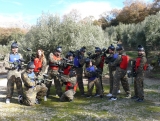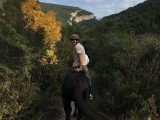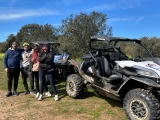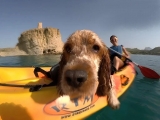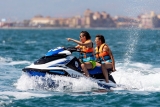Araceli Segarra is a multifaceted woman in every sense. She has dedicated her life to her true passion: the mountains. She has practised all kinds of sports that connect her with this environment, where she thrives, and has travelled the world climbing the highest peaks. Her record is impressive, not just as a climber, but she has also been involved in filming documentaries, collaborating on radio and TV programmes, and even writing and illustrating children's stories. All of this has a common thread: adventure sports.

In an interview for Yumping.com, I saw how the Catalan woman exudes confidence and humility—qualities not everyone possesses. May Tina accompany her on many more journeys, and may she enjoy them as much as she does now.
Yumping: You became a climber, even though you started with caving. How did you switch from one sport to another?
Araceli Segarra: I switched a long time ago. Honestly, I started caving by chance because it was one of the courses offered by the club I was in, and it was a way to experience the mountains. Through caving, I came into contact with other mountain disciplines, and since I’m quite curious and like to try everything, I began exploring other activities like ski mountaineering, rock climbing, and eventually, some of these took me to breathtaking places. I settled on an outdoor sport (laughs).
Y: And not long after, at 21, you were already on an expedition in the Himalayas...
A.S.: I wouldn’t say I was too young—these days, there are kids much younger who travel to other countries and go climbing. I didn’t start travelling very young either because I had to work and save money for my trips. My family couldn’t fund my travels at any point—I paid for everything myself. I know people who went to the Andes at 14 or Africa at 16... I had to wait until I was 21 (laughs).

Y: But you’ve climbed very high peaks since you started, rather than taking it step by step—you’ve always gone big, right?
A.S.: What’s true is that I never set myself easy challenges when I was young—maybe that’s the difference. For example, when I went to Africa, I didn’t climb Kilimanjaro; instead, I took a difficult route up Mount Kenya.
Y: At 22, you climbed the eight-thousander that Edurne Pasaban recently abandoned, Shisha Pangma. How do you remember that moment?
A.S.: It was quite an experience because we took a difficult route—there were just three of us, no ropes, no other expeditions... No one else was on the entire mountain. I guess you also have to be determined, and we were very stubborn about opening that route.
Y: What happens when you have to turn back?
A.S.: I’ve turned back many times. The last time I was on Kangchenjunga, I lost all my gear—no tent, no sleeping bags... and I paid for everything out of my own pocket. The weather was terrible—I always keep a diary and note the conditions; during the two-month expedition, there were only 3 or 4 sunny days. It cost me a lot of money, and on top of that, we lost our gear. Sometimes we take more risks than we should, though I’ve always been very careful—I’d rather turn back in time than break a nail (laughs).

Y: From there, you’ve racked up successes, becoming the first woman to climb Everest and winning some awards. Did you ever imagine you’d go so far?
A.S.: No, because I do things instinctively, out of passion. I don’t plan long-term—I never fixated on climbing Everest. Though on other occasions, we did set goals, like when we climbed the Hornbein Couloir via a difficult route, without oxygen, fixed ropes, or porters.
What I do depends on the moment—as they say in Mexico, "if it feels right." Climbing Everest seemed like a good idea, but I was more passionate about making the documentary than the summit itself (laughs). Sometimes one thing leads to another.

Y: Which style of climbing do you feel most comfortable with?
A.S.: It depends—sometimes mixed climbing can be beautiful. At times, I prefer rock, but other times I fancy ice more. I vary it—I love exploring all mountain disciplines and being as well-rounded as possible.
Y: Has it been hard to make your way in a world where most mountaineers are men?
A.S.: I don’t surround myself with people who treat me differently because I’m a woman. We’re teammates who accept each other for our skills and qualities as individuals. I don’t see it as having to "make my way"—I’m in a group that accepts me for who I am, just as I accept them. Gender isn’t a factor, at least with the people I’m with. If that were the case, I’d have to change teammates (laughs). There are groups for everything, like in any field—whether it’s a hospital or a circus... you have to find the right environment and the right people.
Y: You balanced climbing with your university degree in physiotherapy and a postgraduate in paediatric physiotherapy. What was it like being a student-climber?
A.S.: It was a tough time because I’d train every morning, go home, and then attend university in the afternoons. But I couldn’t go out partying or have the social life my classmates did because the next day I might have a training test. I was a bit distant from my university friends, but it was worth it—I was doing what I wanted and needed to do at the time.

Y: You’re also multi-talented: you’ve worked in TV and radio, published a series of children’s stories, and even starred in a film with none other than Brad Pitt... Does this show that Araceli is a restless woman?
A.S.: Yes, but everything I do is related to the same theme: nature, sport, health, the mountains... I don’t stray from that—for example, I don’t do a cooking show or write astrology stories; I make nature or sports programmes and mountain tales... it’s all connected.
Y: But it’s allowed you to move in many fields you might not have entered otherwise.
A.S.: Yes, but I think you seek things out—when your passion is one thing, you discover many variations around it. Exploring, working, and learning is what I do with the mountains—I see all the branches, all the opportunities, all the options they offer, and I research them. There’s always something new to do...

Y: You’ve also had a modelling career, starring in ad campaigns for Elle, Vogue, and many other media outlets... What led you to that?
A.S.: I see it as more of an anecdote. It’s just a concept: fashion in nature, an idea of health, multifaceted women who don’t stay at home and fight for what they want... Even that’s connected and makes sense. It’s fun being a model (laughs).
Y: A woman as busy as you—what do you do in your free time?
A.S.: When I have free time, I climb. I just got back from four days of climbing in France. I was with my people, and while climbing, you have time to talk about many things and relax, even if it doesn’t seem like it. The rest of the time, I work—creating new stories, writing and illustrating them... It takes me hours to do the drawings and stories, but I enjoy it because different fields help me disconnect from each other.

Y: With the series of stories you’re writing and gradually publishing, I suppose you’re trying to pass on your passion for sport to children, among other things, right?
A.S.: More than just sport, I try to bring back the idea of what a trip offers—you’re not just climbing a mountain but discovering a country, a culture... Sometimes, the experience of sharing with others teaches you a lot, and though it’s subtle because it’s for children, through Tina, the travelling character, I try to add little lessons.

Y: You also practise other adventure sports, like MTB, snowboarding, skiing... What motivates you to do so much?
A.S.: It lets you disconnect in a wild way, but it also helps me keep learning—practising many disciplines means I’m not an expert in any. That pushes me to improve, to keep learning, because there’s always more to learn. Plus, it helps me disconnect, focus, and stay grounded.
Y: Could it also be seen as a drive to push yourself?
A.S.: Yes, and as an exercise in humility—you realise that if you’re cycling well, you can’t climb well, and if you’re climbing well, you can’t ski mountaineer. You can’t excel at everything, so it’s a daily lesson in humility.

Y: What’s your next project?
A.S.: I don’t know yet—this year I’ve done three expeditions and have a few things up in the air. I finalise expeditions a month and a half in advance because I pay for them myself and don’t seek sponsors... I don’t need to sell my trips to any media, so I can do what I want—I don’t owe anyone anything, which is a huge advantage. Next year I have 3 or 4 different projects, including documentaries, but, as I said, it’s all up in the air... I have things to define and choose, but I think that’s good. The best thing is creating, inventing projects—it keeps you excited about something.





